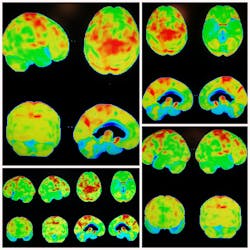In a small study, researchers at the National Institutes of Health have found that positron emission tomography (PET) scans of the heart may identify people who will go on to develop Parkinson’s disease or Lewy body dementia among those at-risk for these diseases.
The findings, published in the Journal of Clinical Investigation and led by scientists at the National Institute of Neurological Disorders and Stroke (NINDS), part of NIH, may advance efforts to detect the earliest changes that years later lead to Parkinson’s disease and Lewy body dementia.
In 34 people with Parkinson’s disease risk factors, researchers conducted PET scans of the heart to gain insight into levels of the neurotransmitter norepinephrine. They found that the scans could distinguish individuals who would later be diagnosed with Parkinson’s or Lewy body dementia—both are brain diseases caused by abnormal deposits of the protein alpha-synuclein that form clumps known as Lewy bodies. The research was conducted at the NIH Clinical Center, currently the only location for 18F-dopamine PET scanning.
In the present study, the research team led by David S. Goldstein, M.D., Ph.D., NINDS Principal Investigator, found that at-risk individuals with low 18F-dopamine-derived radioactivity in the heart were highly likely to develop Parkinson’s or Lewy body dementia during long-term follow-up, compared to individuals with the same risk factors but with normal radioactivity. PET scans work by using a radioactive tracer to visualize metabolic or biochemical processes in body organs.
In the study, 34 people at risk for Parkinson’s had cardiac 18F-dopamine PET scans every 18 months for up to about 7.5 years or until they were diagnosed with the disease. Participants had three or more Parkinson’s risk factors, which included a family history of the disease; loss of sense of smell, which occurs commonly in Parkinson’s; a sleep disorder in which people act out their dreams, known as dream enactment behavior; and symptoms of orthostatic intolerance, such as light-headedness upon standing.
Of the nine individuals with low cardiac 18F-dopamine-derived radioactivity at their first scan, eight were diagnosed later with Parkinson’s or Lewy body dementia. Only 1 of 11 participants with normal initial radioactivity developed a central Lewy body disease. All nine participants who developed a Lewy body disease had low radioactivity before or at the time of diagnosis.

